engine Oldsmobile Aurora 1998 Owner's Manuals
[x] Cancel search | Manufacturer: OLDSMOBILE, Model Year: 1998, Model line: Aurora, Model: Oldsmobile Aurora 1998Pages: 380, PDF Size: 19.75 MB
Page 7 of 380

@ The 1998 Oldsrnobile Aurora Owner’s Manual
1-1
2- 1
3-1
4-1
5-1
6-1
7- 1
8- 1
9- 1
Seats and Restraint Systems
This section tells you how to use your seats and safety belts properly. It also explains the “SRS” system.
Features and Controls
This section explains how to start and operate your vehicle.
Comfort Controls and Audio Systems
This section tells you how to adjust the ventilation and comfort controls and how to operate your audio system.
Your Driving and the Road
Here you’ll find helpful information and tips about the road and how to drive under different conditions.
Problems on the Road
This section tells what to do if you have a problem while driving, such as a flat tire or overheated engine, etc.
Service and Appearance Care
Here the manual tells you how to keep your vehicle running properly and looking good.
Maintenance Schedule
This section tells you when to perform vehicle maintenance and what fluids and lubricants to use.
Customer Assistance Information
This section tells you how to contact Oldsmobile for assistance and how to get service and owner publications.
It also gives you information on “Reporting Safety Defects” on page
8-8.
Index
Here’s an alphabetical listing of almost every subject in this manual. You can use it to quickly find
something you want to read.
i
Page 11 of 380
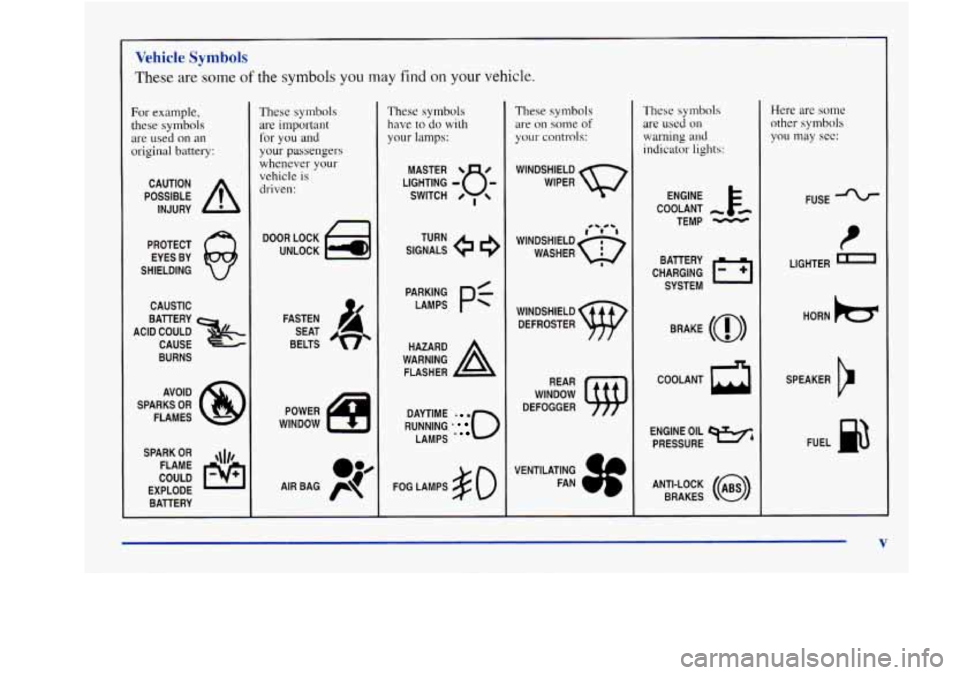
Vehicle Symbols
These are some of the symbols you may find on your vehicle.
For example,
these
symbols
are used on an
original battery:
POSSIBLE A
CAUTION
INJURY
PROTECT EYES BY
SHIELDING
CAUSTIC
BURNS AVOID
SPARKS
OR
FLAMES
SPARK
OR ,\I/,
COULD FLAME
EXPLODE BATTERY
These symbols
are important
for you and
your passengers
whenever
your
vehicle is
driven:
DOOR LOCK
UNLOCK
FASTEN SEAT
BELTS
POWER
WINDOW
These symbols have
to do with
your lamps:
SIGNALS e e3
TURN
RUNNING
* 0
DAYTIME - a
LAMPS .
FOG LAMPS # 0
These symbols
are on some of
your controls:
WINDSHIELD
WIPER
WINDOW
DEFOGGER
VENTILATING FAN
These symbols
are used on
warning and
indicator lights:
COOLANT -
TEMP -
CHARGING I-1
BATTERY
SYSTEM
BRAKE
(0)
h
ENGINE OIL e,
PRESSURE
ANTI-LOCK
(@)
BRAKES
Here are some
other symbols
you may see:
FUSE -%-
LIGHTER n
HORN )tr
SPEAKER
b
FUEL E3
V
Page 67 of 380
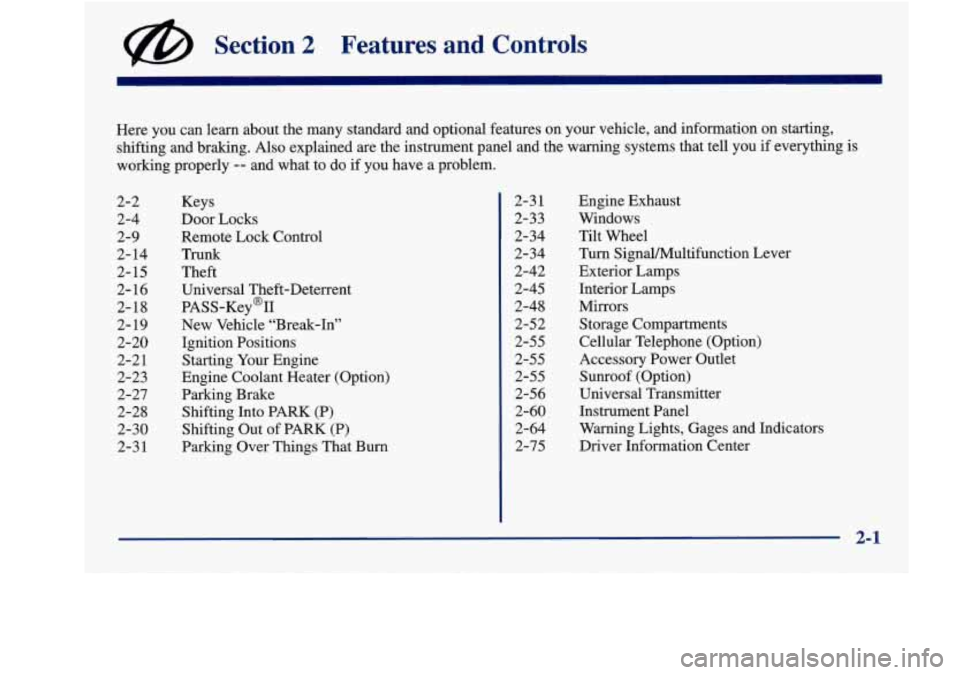
Section 2 Features and Controls
Here you can learn about the many standard and optional features on your vehicle, and information on starting,
shifting
and braking. Also explained are the instrument panel and the warning systems that tell you if everything is
working properly
-- and what to do if you have a problem.
2-2
2-4
2-9
2- 14
2-15
2- 16
2-1s
2- 19
2-20
2-21
2-23
2-27
2-28
2-30
2-3
1
Keys
Door Locks
Remote Lock Control TrUIlk
Theft
Universal Theft-Deterrent
PASS-Key(%
New Vehicle “Break-In”
Ignition Positions Starting Your Engine
Engine Coolant Heater (Option)
Parking Brake
Shifting Into PARK (P)
Shifting Out of PARK (P)
Parking Over Things That Burn 2-3 1
2-3
3
2-34
2-34
2-42
2-45
2-48
2-52
2-55
2-55 2-55
2-56
2-60
2-64
2-75 Engine Exhaust
Windows
Tilt Wheel
Turn SignaVMultifunction Lever
Exterior Lamps Interior Lamps
Mirrors
Storage Compartments
Cellular Telephone (Option)
Accessory Power Outlet
Sunroof (Option)
Universal Transmitter
Instrument Panel
Warning Lights, Gages and Indicators
Driver Information Center
2-1
Page 75 of 380
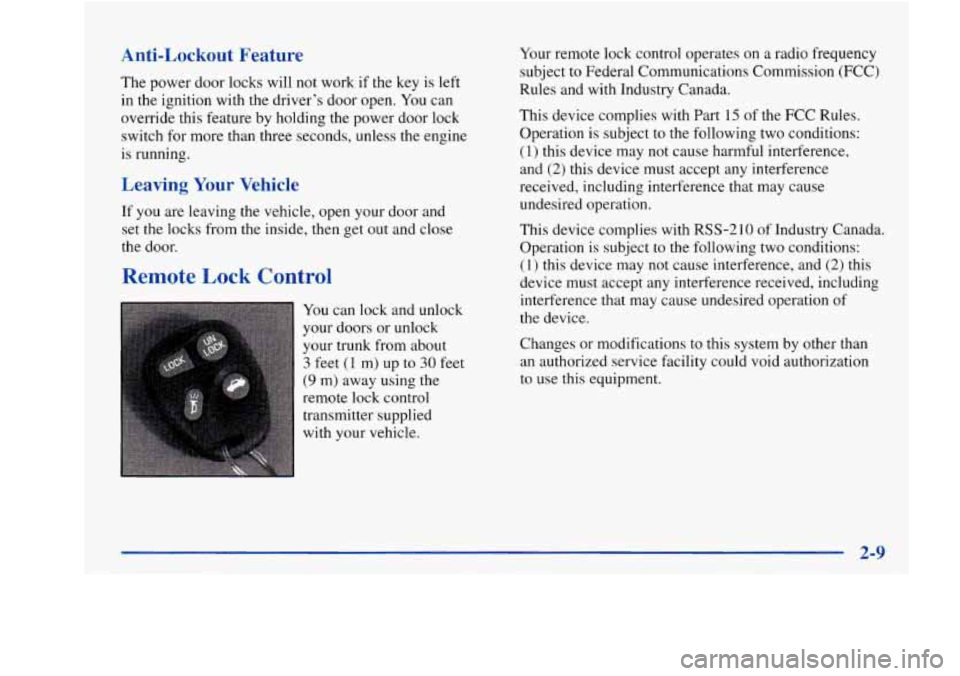
Anti-Lockout Feature
The power door locks will not work if the key is left
in the ignition with the driver’s door open. You can
override this feature by holding
the power door lock
switch for more than three seconds, unless the engine
is running.
Leaving Your Vehicle
If you are leaving the vehicle, open your door and
set the locks from the inside, then get out and close
the door.
Remote Lock Control
You can lock and unlock
your doors or unlock
your trunk from about
3 feet (1 m) up to 30 feet
(9 m) away using the
remote lock control
transmitter supplied
with your vehicle. Your
remote lock control operates on a radio frequency
subject to Federal Communications Commission (FCC)
Rules and with Industry Canada.
This device complies with Part
15 of the FCC Rules.
Operation is subject to the following two conditions:
(1) this device may not cause harmful interference,
and
(2) this device must accept any interference
received, including interference that may cause
undesired operation.
This device complies with RSS-210 of Industry Canada.
Operation is subject to the following two conditions:
(1) this device may not cause interference, and (2) this
device must accept any interference received, including
interference that may cause undesired operation
of
the device.
Changes or modifications to this system by other than
an authorized service facility could void authorization
to use this equipment.
Page 81 of 380

A CAUTION:
It can be dangerous to drive with the trunk lid
open because carbon monoxide
(CO) gas can
come into your vehicle. You can’t see
or smell
CO. It can cause unconsciousness and even death.
If you must drive with the trunk lid open or if
electrical wiring or other cable connections must
pass through the seal between the body and the
trunk lid:
0 Make sure all windows are shut.
Turn the fan on your heating or cooling
system to its highest speed with the setting
on
any airflow selection except RECIRC.
That will force outside air into your vehicle.
See “Comfort Controls” in the Index.
instrument panel, open them all the
way.
0 If you have air outlets on or under the
See “Engine Exhaust” in the Index.
Theft
Vehicle theft is big business, especially in some cities.
Although your vehicle has a number of theft-deterrent
features, we know that nothing we put on it
can make
it impossible
to steal. However, there are ways you
can help.
Key in the Ignition
If you leave your vehicle with the keys inside, it’s an
easy target for joy riders or professional thieves
-- so
don’t do it.
With the ignition off and the driver’s door open, you’ll
hear a chime reminding you to remove your key from
the ignition and take
it with you. Always do this. Your
steering wheel will be locked, and
so will your ignition
and transaxle. And remember to lock the doors.
Parking at Night
Park in a lighted spot, close all windows and lock your
vehicle. Remember to keep your valuables out
of sight.
Put them in a storage area, or take them with you.
2-15
Page 84 of 380
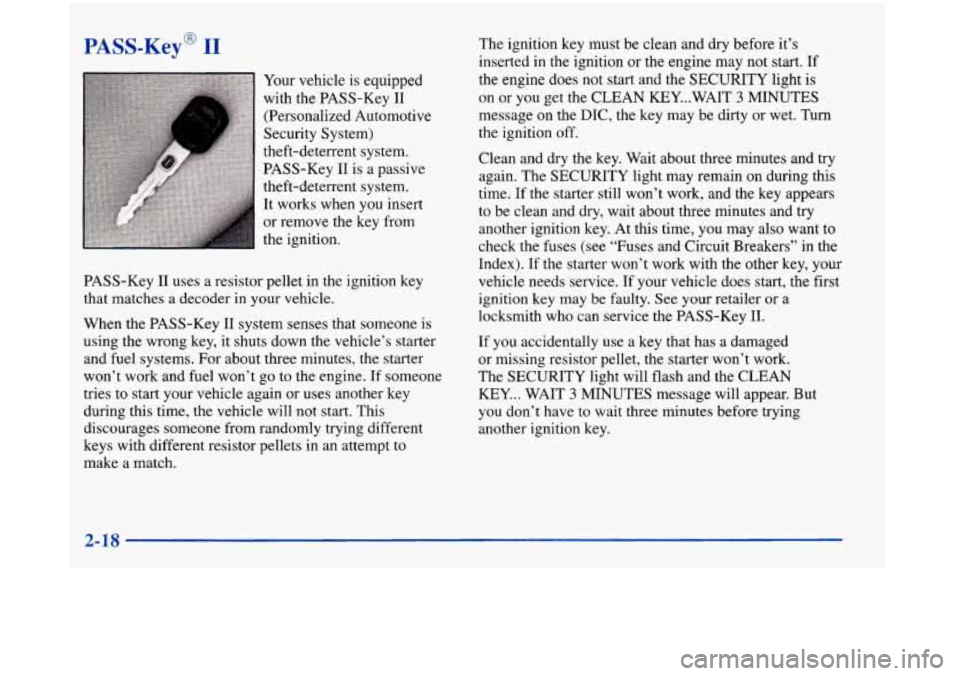
PASS-Key@ I1
Your vehicle is equipped
with the PASS-Key I1
(Personalized Automotive
Security System)
theft-deterrent system.
PASS-Key I1 is a passive
theft-deterrent system.
It works when you insert
or remove the key from
the ignition.
PASS-Key
I1 uses a resistor pellet in the ignition key
that matches a decoder in your vehicle.
When the PASS-Key
I1 system senses that someone is
using the wrong key, it shuts down the vehicle’s starter
and fuel systems. For about three minutes, the starter
won’t work and fuel won’t go to the e,ngine. If someone
tries to start your vehicle again or uses another key
during this time, the vehicle will not start. This
discourages someone from randomly trying different
keys with different resistor pellets in an attempt to
make a match. The ignition key must be clean and dry before
it’s
inserted in the ignition or the engine may not start. If
the engine does not start and the SECURITY light
is
on or you get the CLEAN KEY...WAIT 3 MINUTES
message on the DIC, the key may be dirty or wet.
Turn
the ignition off.
Clean and dry the key. Wait about three minutes and try
again. The SECURITY light may remain on during this
time. If
the starter still won’t work, and the key appears
to be clean and dry, wait about three minutes and try
another ignition key. At this time, you may also want to
check the fuses (see “Fuses and Circuit Breakers” in the
Index). If the starter won’t work with the other key, your
vehicle needs service. If your vehicle does start, the first
ignition key may be faulty. See your retailer
or a
locksmith who can service the PASS-Key
11.
If you accidentally use a key that has a damaged
or missing resistor pellet, the starter won’t work.
The SECURITY light will flash and the CLEAN
KEY... WAIT 3 MINUTES message will appear. But
you don’t have
to wait three minutes before trying
another ignition key.
2-18
Page 85 of 380
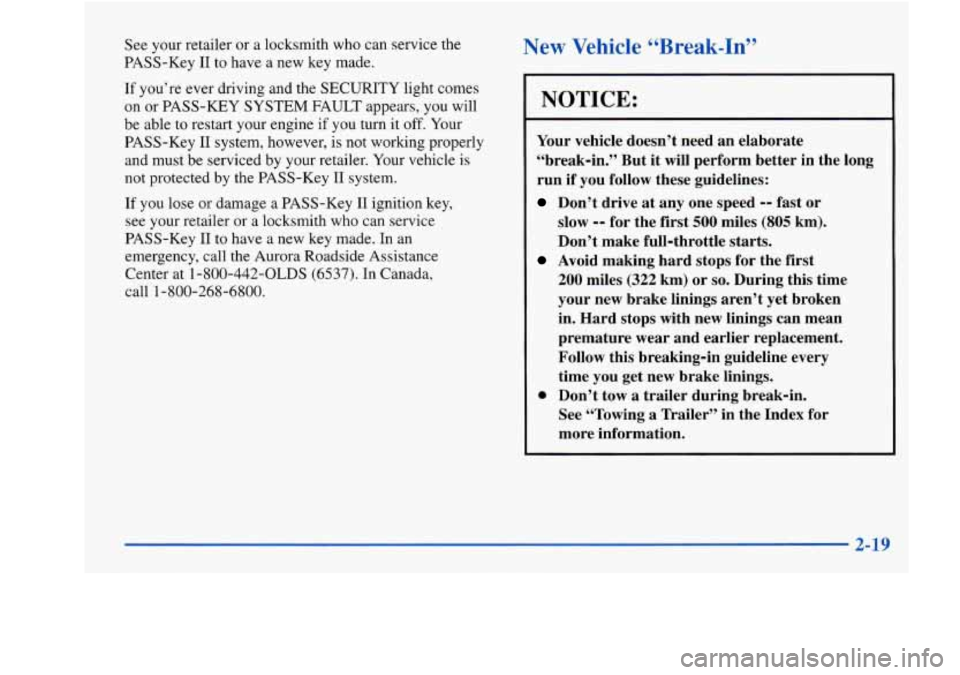
See your retailer or a locksmith who can service the
PASS-Key I1 to have a new key made.
If you’re ever driving and the SECURITY light comes
on or PASS-KEY SYSTEM
FAULT appears, you will
be able
to restart your engine if you turn it off. Your
PASS-Key
I1 system, however, is not working properly
and must be serviced
by your retailer. Your vehicle is
not protected by the PASS-Key I1 system.
If you lose
or damage a PASS-Key I1 ignition key,
see your retailer
or a locksmith who can service
PASS-Key
I1 to have a new key made. In an
emergency, call the Aurora Roadside Assistance
Center at
1-800-442-OLDS (6537). In Canada,
call
1-800-268-6800.
New Vehicle 44Break-In”
NOTICE:
Your vehicle doesn’t need an elaborate
“break-in.” But it will perform better in the long
run if you follow these guidelines:
Don’t drive at any one speed -- fast or
slow
-- for the first 500 miles (805 km).
Don’t make full-throttle starts.
200 miles (322 km) or so. During this time
your new brake linings aren’t yet broken
in. Hard stops with new linings can mean
premature wear and earlier replacement.
Follow this breaking-in guideline every
time you get new brake linings.
Don’t tow
a trailer during break-in.
See “Towing
a Trailer” in the Index for
more information.
Avoid making hard stops for the first
2-19
Page 86 of 380
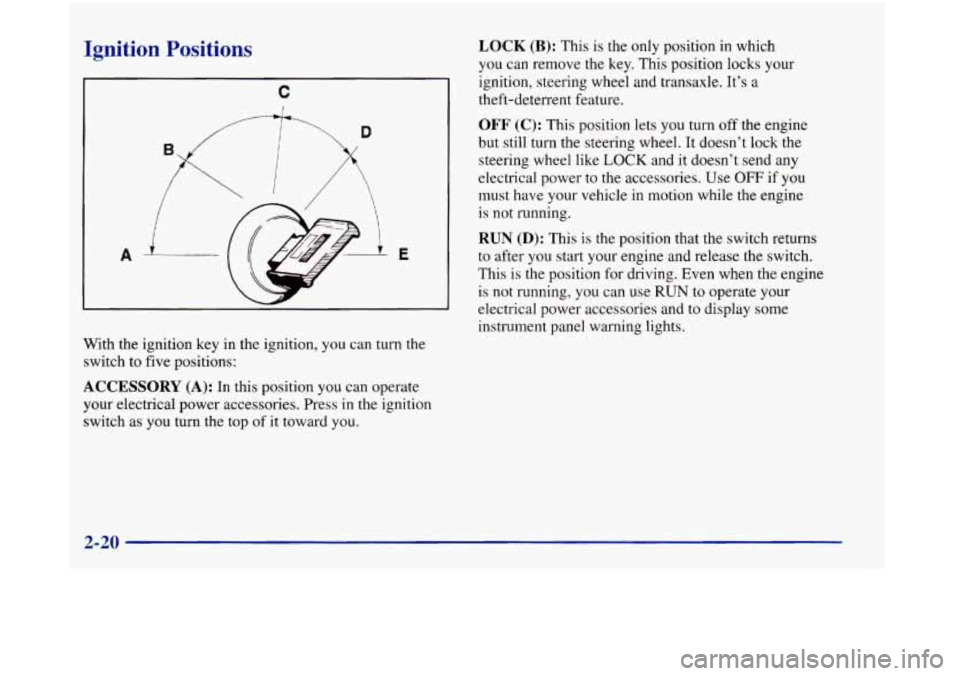
Ignition Positions
C
I
A E
With the ignition key in the ignition, you can turn the
switch to five positions:
ACCESSORY (A): In this position you can operate
your electrical power accessories. Press in the ignition
switch as you turn the top
of it toward you.
LOCK (B): This is the only position in which
you can remove the
key. This position locks your
ignition, steering wheel and transaxle. It’s a
theft-deterrent feature.
OFF (C): This position lets you turn off the engine
but still turn the steering wheel. It doesn’t lock the steering wheel like
LOCK and it doesn’t send any
electrical power
to the accessories. Use OFF if you
must have your vehicle in motion while the engine
is not running.
RUN (D): This is the position that the switch returns
to after you start your engine and release the switch.
This
is the position for driving. Even when the engine
is not running, you can
use RUN to operate your
electrical power accessories and to display some
instrument panel warning lights.
Page 87 of 380
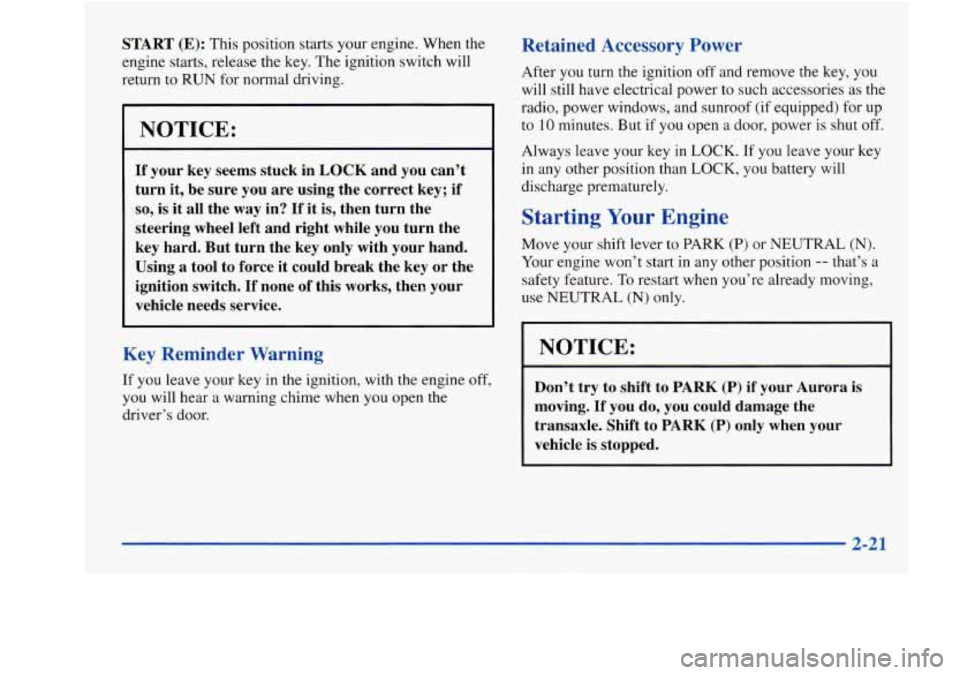
START (E): This position starts your engine. When the
engine starts, release the key. The ignition switch will
return to
RUN for normal driving.
FNOTICE:
If your key seems stuck in LOCK and you can’t
turn
it, be sure you are using the correct key; if
so, is it all the way in? If it is, then turn the
steering wheel left and right while you turn the
key hard. But turn the key only with your hand.
Using
a tool to force it could break the key or the
ignition switch.
If none of this works, then your
vehicle needs service.
Key Reminder Warning
If you leave your key in the ignition, with the engine off,
you will hear a warning chime when you open the
driver’s door.
Retained Accessory Power
After you turn the ignition off and remove the key, you
will still have electrical power to such accessories
as the
radio, power windows, and sunroof (if equipped) for up
to
10 minutes. But if you open a door, power is shut off.
Always leave your key in
LOCK. If you leave your key
in any other position than
LOCK, you battery will
discharge prematurely.
Starting Your Engine
Move your shift lever to PARK (P) or NEUTRAL (N).
Your engine won’t start in any other position -- that’s a
safety feature.
To restart when you’re already moving,
use NEUTRAL
(N) only.
NOTICE:
~ ~ ~~
Don’t try to shift to PARK (P) if your Aurora is I
moving. If you do, you could damage the
transaxle. Shift to PARK
(P) only when your
vehicle is stopped.
Page 88 of 380
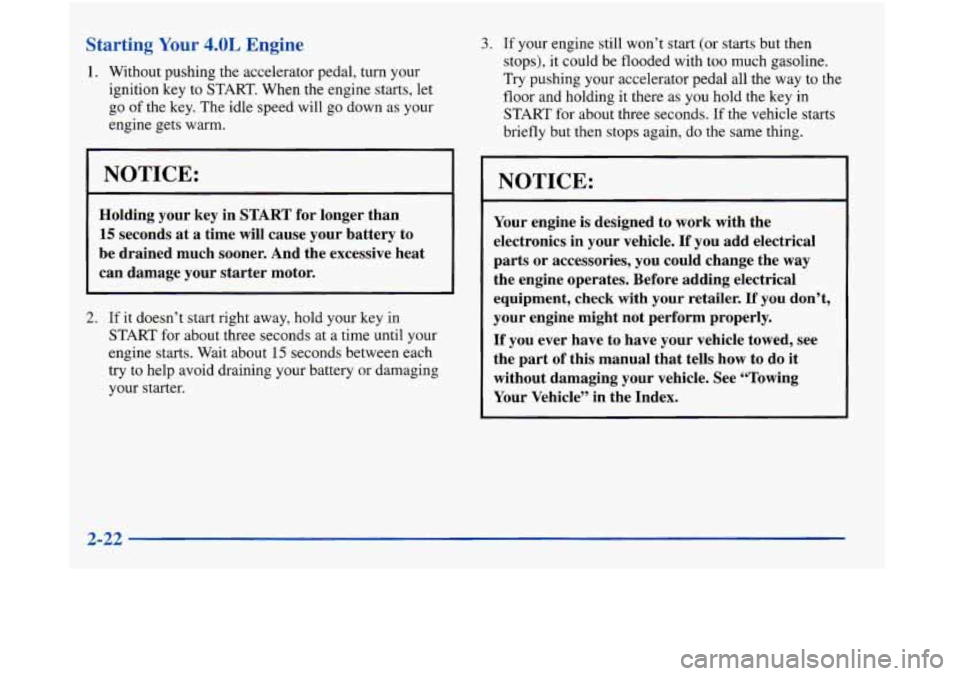
Starting Your 4.0L Engine
1. Without pushing the accelerator pedal, turn your
ignition key to START. When the engine starts, let
go of the key. The idle speed will go down as
your
engine gets warm.
I 1
I NOTICE:
Holding your key in START for longer than
15 seconds at a time will cause your battery to
be drained much sooner. And the excessive heat
can damage
your starter motor. I
2. If it doesn’t start right away, hold your key in
START for about three seconds at a time until your
engine starts. Wait about
15 seconds between each
try to help avoid draining your battery or damaging
your starter.
3. If your engine still won’t start (or starts but then
stops), it could be flooded with too much gasoline.
Try pushing your accelerator pedal all the way to the
floor and holding it there as you hold the key in
START for about three seconds.
If the vehicle starts
briefly but then stops again,
do the same thing.
NOTICE:
Your engine is designed to work with the
electronics in your vehicle.
If you add electrical
parts or accessories,
you could change the way
the engine operates, Before adding electrical
equipment, check with
your retailer. If you don’t,
your engine might not perform properly.
If you ever have to have your vehicle towed, see
the part of this manual that tells how to do it
without damaging your vehicle. See “Towing
Your Vehicle”
in the Index.
2-22